"Pal Joey," Past and Present
Richard Rodgers, Lorenz Hart, & John O'Hara Reimagined at City Center
“Pal Joey”
Presented at City Center
Original Book: John O’Hara
Revised Libretto: Richard Lagravenese & Daniel “Koa” Beaty
Lyrics: Lorenz Hart
Music: Richard Rodgers
“To my dear friend Ted...Hey Brother man, it’s Joey here. I thought it was time to reach out, write you some words to put those bad, bad times behind us. We both did some things. And breaking up a band...well, it just ain’t worth breaking up a friendship, brother. Not one that goes as far back as we do.” Or so Pal Joey, as presented by City Center Encores! this past weekend, begins.
In 1940, the great innovation of Pal Joey was the title character, Joey Evans himself. Before Richard Rodgers and Lorenz Hart, working with the great novelist John O’Hara, no one in the musical theater had ever tried to create such a complicated, finely nuanced character before. Joey is extremely talented and has a charm that’s positively magnetic - to the point where it made sense to have him played by Gene Kelly in the original production and Frank Sinatra in the later movie version - but he’s also conceited, kind of dumb, and supremely self-centered. In short, he’s lovable and repulsive at the same time, fully three-dimensional, like literally no one on the Broadway stage before him and precious few in the eighty years since. No wonder both Kelly and Sinatra tore into the role.
(I have a theory that O’Hara based the broad outlines - in multiple senses of the term - of the Joey character on the great nightclub entertainer Joe E. Lewis, with the caveat that in real life, Joe E. did not share any of Joey’s negative traits. In fact, Joey is essentially Joe E.’s evil twin, but that’s a story for another substack.)
Further, in 1940, Broadway was the stuff of glamor and glitz - Ziegfeld had been dead for almost a decade but he was still the biggest name in musical theater. To do a Broadway show set on the bottom rung of what was considered the lowest depths of what was barely considered “show biz” - seedy nightclubs and burlesque houses - was also an exciting and highly original idea. (As “Lois” says to “Bill” in Kiss Me, Kate, “Do you want to work in night clubs all your life?”)
In its first three incarnations - the 1940 original production, the 1952 Broadway revival, and the 1957 film adaptation - Pal Joey was a resounding hit; in fact, it spoke to the 1950s even better than it did to the ‘40s. (The same could be said for the first three cast albums: the first recording, produced by Columbia Records with a studio cast in 1950, the revival cast - or some of it - on Capitol Records in 1952, and the soundtrack album, also on Capitol, from 1957.

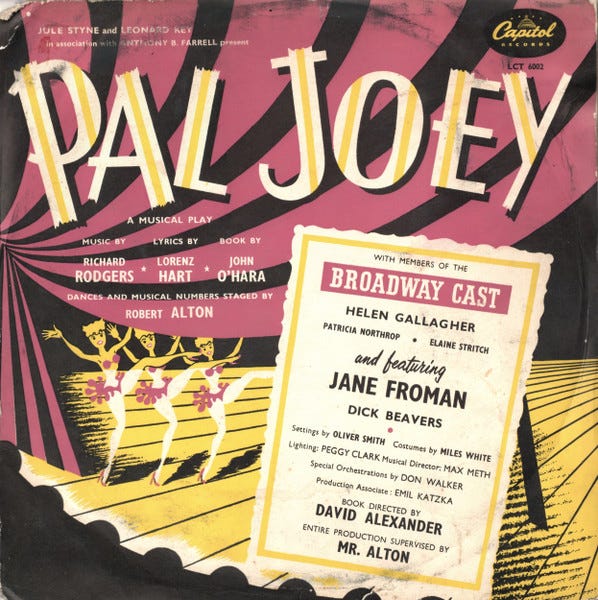
Since the movie, there have been three attempts at bringing Joey back to Broadway, in 1963, 1976, and 2008, none of them particularly successful. In 1998, City Center Encores! staged a concert production starring Peter Gallagher and Patti LuPone, which culminated in the best of all Joey cast albums.
Twenty-five years later - and well over 80 since the first production - City Center has brought Joey back, this time with a difference. In approaching the new revision, one has to first accept the notion that this is essentially not the show directed and produced by George Abbott and choreographed by Robert Alton, as written by Rodgers, Hart, and O’Hara, although much of the creative team’s work is still there, albeit jangled and reshuffled.
It’s as if City Center has decided that Joey, based on the evidence of the three unsuccessful revivals, is no longer relevant to the world after 1960; thus, they came up with the idea of making the Joey character African American. In 1940, it was considered shocking to show a down-and-out nightclub emcee having an openly sexual relationship with a slightly older, significantly wealthier woman. Clearly the Joey-Vera affair wouldn’t bother anyone today - even though on the stage, “Mrs. Simpson” was still married. (This was altogether too steamy for Hollywood in 1957; thus, Rita Hayworth plays Vera opposite Sinatra as a widow.) However, even looking backwards with the eyes of 2023, we can see how a Black singer sleeping with a rich white woman would have been a big deal in 1940.
This is a good idea - it gives us a new reason to revive Pal Joey. Additionally, as critic Adam Feldman observes of the current production, “Basically, it approaches the songs of Rodgers and Hart as jazz standards—which is mostly why we care about them now anyway—instead of freezing them as theater songs.”
Many of the decisions made by new librettists Richard Lagravenese and Daniel “Koa” Beaty, along with directors Tony Goldwyn and Savion Glover, the latter also choreographer, really do work well. Having a Black Joey sexually involved with a white Vera, both believably played by Ephraim Sykes and Elizabeth Stanley, gives the whole work a fresh motivation; when Vera tells us she’s been receiving death threats because of her choice of bed partners, it’s all-too-chillingly believable.
Mr. Sykes’s Joey is perhaps less of a rogue, charming or otherwise, than in previous incarnations. Instead, he’s driven by the idea of what he keeps telling us is the “new music. In his first spoken letter to his buddy Ted (thankfully they retained that framing device idea, a guiding notion of the original stories but abandoned in the film), he speaks of the new modern jazz musicians - Charlie Parker, Dizzy Gillespie, Thelonious Monk. The show opens with “You Mustn’t Kick It Around,” even as it did in 1940, only this time it’s spiced up with trumpeter Alphonso Horne, a few feet behind Mr. Sykes, quoting the Yardbird classic “Ornithology.”
The idea of doing the songs as jazz standards - and also that of interpolating songs from other Rodgers and Hart shows (especially Babes in Arms and The Boys From Syracuse) as done in the 1957 movie is also solid. That’s in spite of how it sometimes seems, as professor Laurence Maslon might observe, like the show is covering itself as it goes along.
But not all the new interpretations work equally well. As in the Sinatra version, Joey teases and seduces Vera, sitting ringside, with “The Lady is a Tramp” (imported from Babes). But here, the arrangement is a cacophonous din, sounding like a rather messy mashup of Rodgers and Hart with Mr. Glover’s 1995-’96 triumph, Bring in 'Da Noise, Bring in 'Da Funk. It’s far more annoying than erotic.
A lot of the specifics are irritatingly off: when Joey croons a love song, he’s accused of sounding like “Bing Crosby dipped in fudge.” This contradicts what Joey tells us earlier in the show, when Crosby’s name is dropped, Joey responds, “Bing Crosby sounds like us! Where do you think he got it from?” Both lines miss the point that Crosby gladly acknowledged his African-American influences and also that he was beloved in the Black community.
At one point, “Melvin Snyder” - the columnist character who was known as “Melba Snyder” in the original - as played by Brooks Ashmanskas, tells us that Joey can never be successful because the epitome of current mainstream musical taste is “I Don’t Want to Set the World on Fire.” We’re not sure if the librettists realize that this top-selling disc of 1940-’41 was written by Black composers and made into a hit by a Black vocal group.
When Joey sings words and music straightforwardly, rather than scatting and funking it up, he’s somehow not being true to himself, and, it is implied, trying to sound "white." Singing a melody so that it can be understood is a white practice? This would have been news to Nat King Cole and Billy Eckstine, not to mention Lena Horne and Ella Fitzgerald, not to mention Sam Cooke and Marvin Gaye.
But a lot of the stuff works. “That Terrific Rainbow” is still a great hoot, which anticipates Gypsy in the way it pokes risqué fun at the presentation of underpaid, underdressed girls in low-rent dives. (Alas, they cut the other dive song, “The Flower Garden of My Heart.”) “I Could Write a Book” remains the very sweet key duet between Joey and his other leading lady, young singer “Linda English.” As played Aisha Jackson, whose singing is sometimes reminiscent of Samara Joy (and that’s a major compliment) she’s a little bit less niavé than the character traditionally is.
And everything that Loretta Devine - as a new character, “Lucille Wallace” - does, musically or comically, is an absolute treat, including leading the five chorus girls in “Sing for Your Supper.” “Bewitched, Bothered And Bewildered” sung by Ms. Stanley in a shiny satin slip, is, as it should be, a smoldering expression of postcoital bliss, although it gets a little loud and belty by the climax.
Act II features two particularly ingenious new interpretations, one right after the other: “Ev’rything I’ve Got” as introduced in By Jupiter (1942) is overtly sarcastic, here it becomes a warmly tender duet between Ms. Devine and Jeb Brown as her white quasi-mobster beau “Tony.” Then we get Mr. Ashmanskas, who played all the white characters (good and mostly bad) in Shuffle Along, Or The Making of the Musical Sensation of 1921 and All That Followed, at full throttle. Here playing a prissy fussbudget of a journalist, he delivers a showstopping rendition of the R&H comedy classic “Zip.” Having this deep delve into the inner mental workings of an intellectual stripper at work - inspired by Gypsy Rose Lee - sung by a man makes for one of the funniest turns in the show; the line “I’m a heterosexual” has never before inspired such a huge laugh.
Another good idea of this production is having a jazz quintet on stage, featuring Mr. Horne and expert veteran pianist Lafayette Harris and the emphatic drummer Alvester Garnett. There’s also an onstage ensemble of speechless tap dancers, meant to represent both a Greek chorus and the African tradition of ancestral griots, who serve to amplify and illuminate Joey’s internal moods. There’s a lot of good stuff here, and I hope they keep working on it. I’m looking forward to receiving another letter from my pal Joey sometime soon.
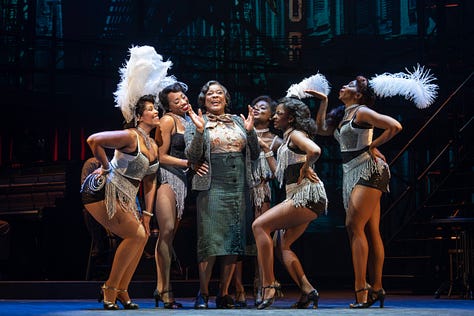
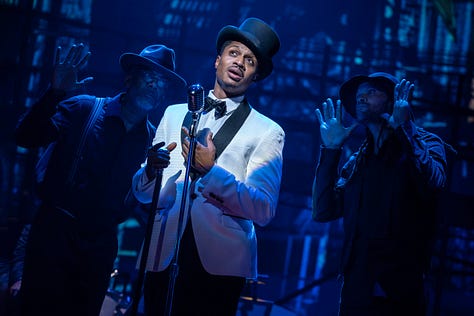
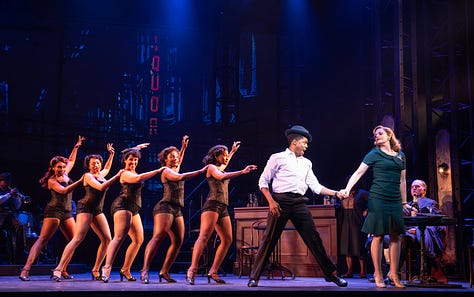
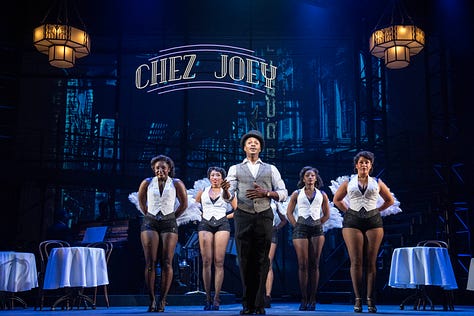
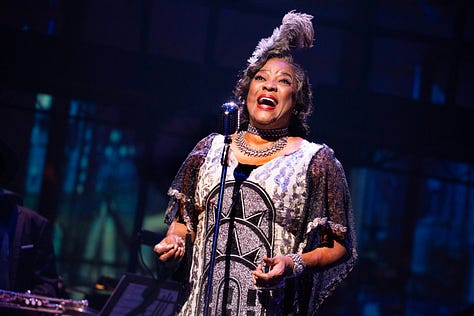
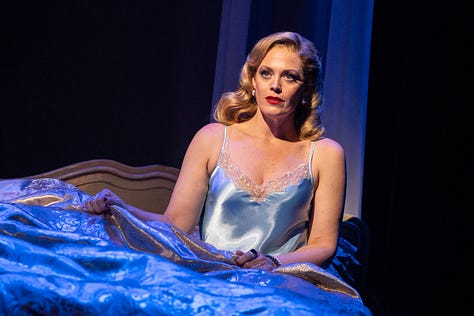
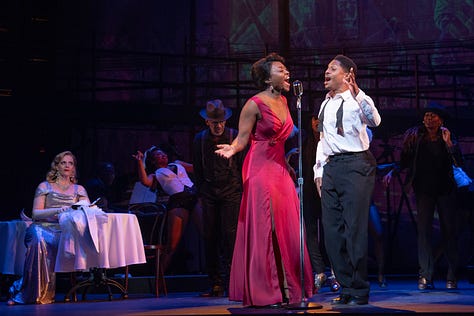
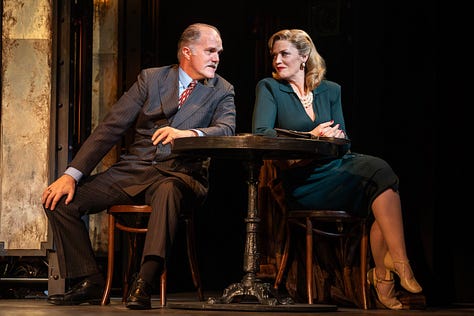
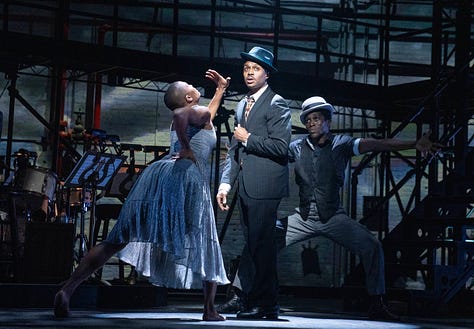
Very Special thanks to the fabulous Ms. Elizabeth Zimmer, for expert proofreading of this page, and scanning for typos, mistakes, and other assorted boo-boos!
Sing! Sing! Sing! : My tagline is, “Celebrating the great jazz - and jazz-adjacent - singers, as well as the composers, lyricists, arrangers, soloists, and sidemen, who help to make them great.”
A production of KSDS heard Saturdays at 10:00 AM Pacific; 1:00PM Eastern.
To listen to KSDS via the internet (current and recent shows are available for streaming.) click here.
The whole series is also listenable on Podbean.com, click here.
Wednesday, November 8
7:00PM (EST) - THE NEW YORK ADVENTURE CLUB presents:
'The Brill Building, Part II: The Rock & Pop Years' Webinar
click here
Wednesday, November 8
9:30PM (EST) - Will Friedwald's CLIP JOINT presents:
Brill Building Encores
no cover charge!
click here
Saturday, November 11
10:00AM Pacific Time / 1:00PM Eastern Time
KSDS San Diego Presents
"DARN THAT DREAM": THE EDDIE DELANGE SONGBOOK
special guest: MR. WARREN DELANGE
for more info and streaming link, click here
SLOUCHING TOWARDS BIRDLAND is a subStack newsletter by Will Friedwald. The best way to support my work is with a paid subscription, for which I am asking either $5 a month or $50 per year. Thank you for considering. Word up, peace out, go forth and sin no more!
Note to friends: a lot of you respond to my SubStack posts here directly to me via eMail. It’s actually a lot more beneficial to me if you go to the SubStack web page and put your responses down as a “comment.” This helps me “drive traffic” and all that other social media stuff. If you look a tiny bit down from this text, you will see three buttons, one of which is “comment.” Just hit that one, hey. Thanks!



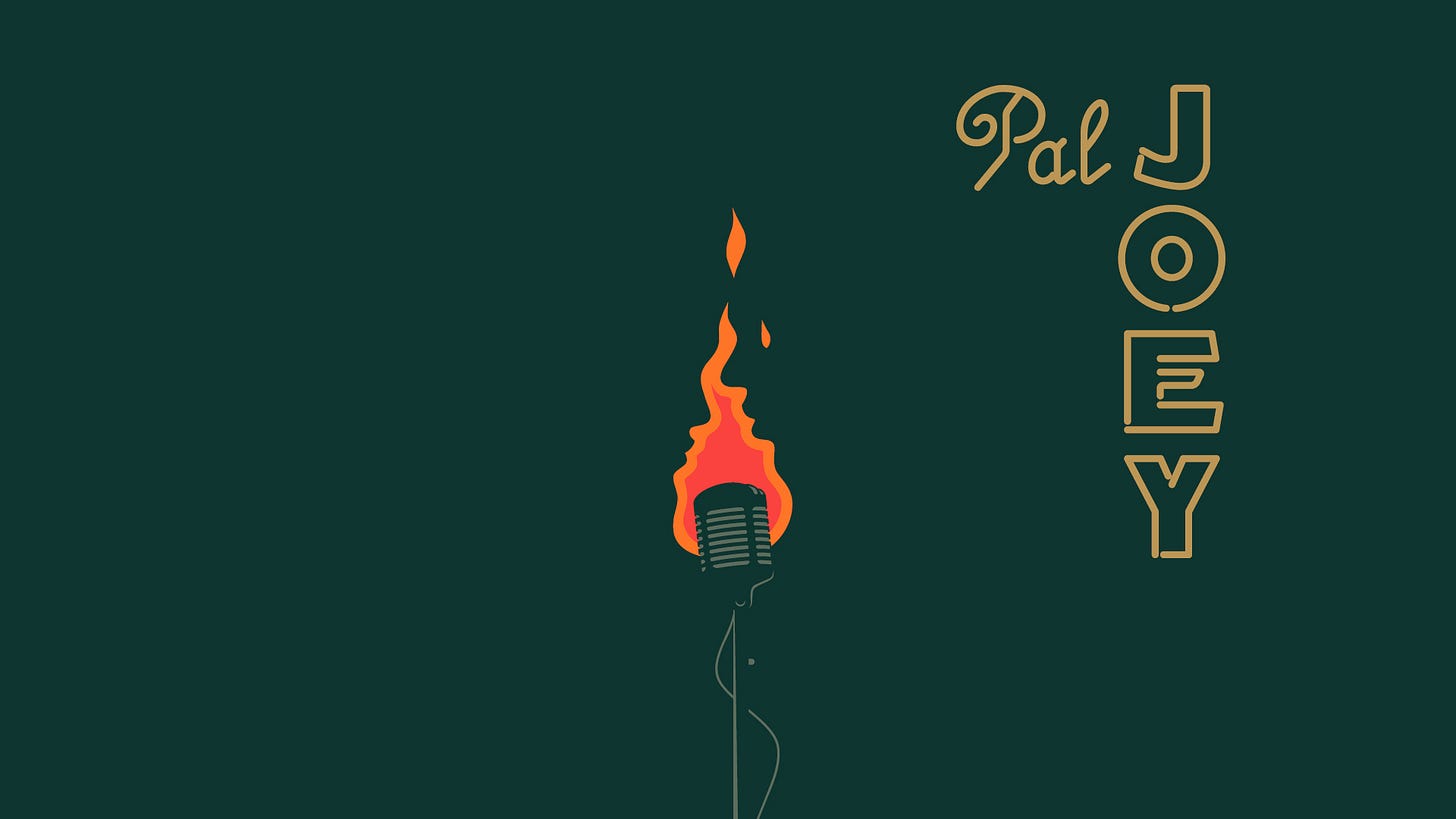


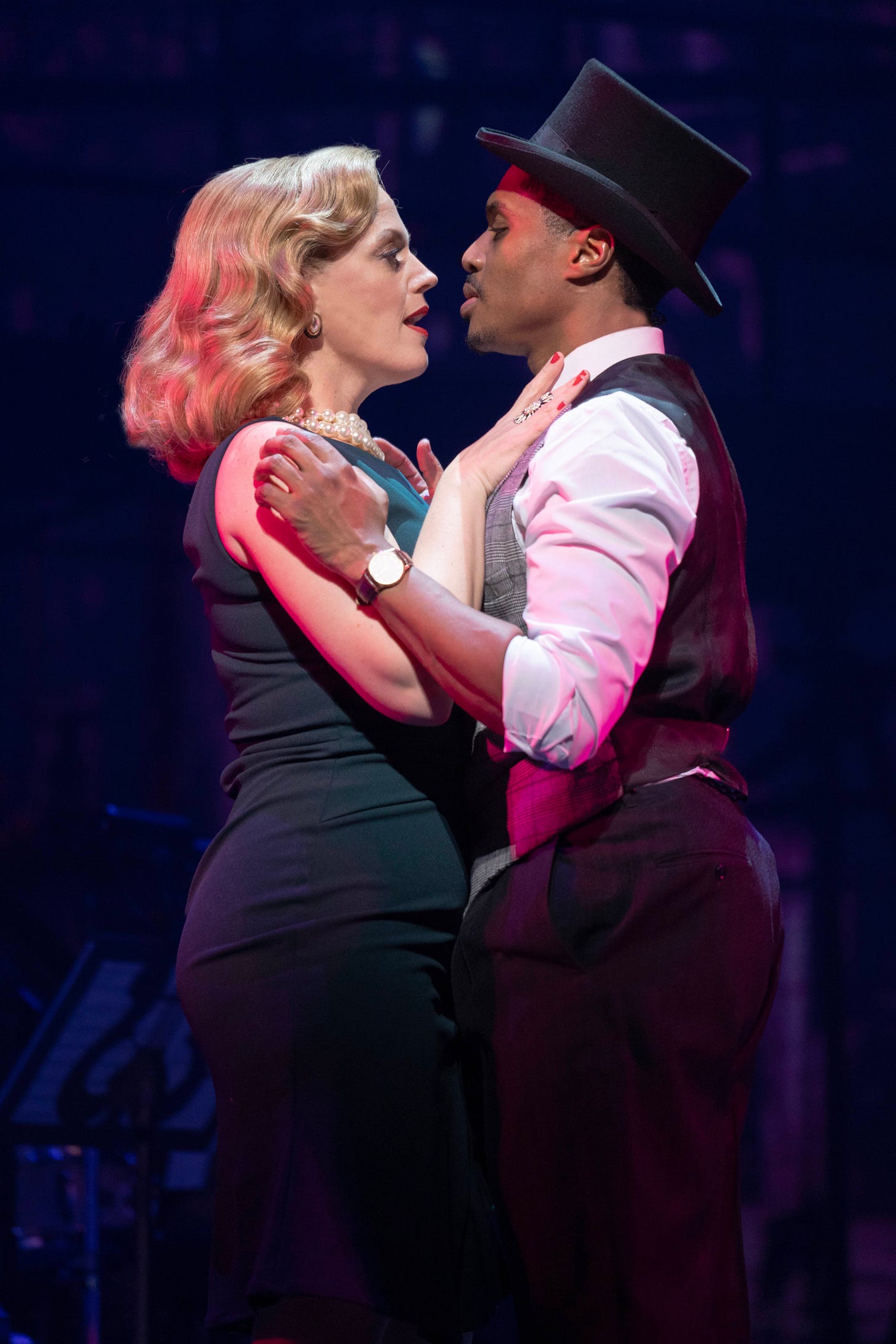


Interesting review of what sounds like an interesting production!
Not too many '40s shows get revived these days. They picked one of the best- Rodgers and Hart endure in the test of time no matter what context their work is placed in.